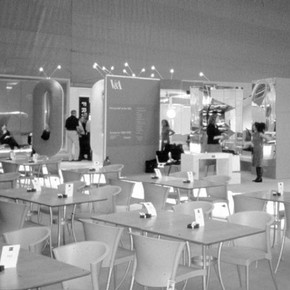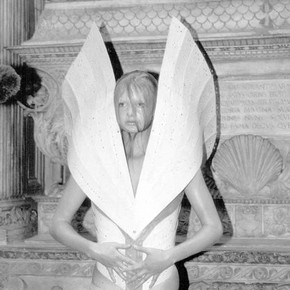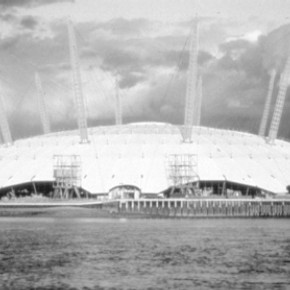Conservation Journal
Spring 2000 Issue 34
Contemporary V&A

Figure 1. Establishing raport with our core audience. The V&A stand at 100% Design, Earls Court, designed by Muf. Photograph by Muf (click image for larger version)
The V&A was founded as a contemporary museum. Purpose-built on a green-field site, its first deliberate collections were selected from brand new products sent from all over the world to the Great Exhibition of 1851. The Museum was, therefore, certainly a showcase for new products. However, what made it a contemporary museum had as much to do with promoting the economic growth of the country as with its role as a repository for new products of comparative design.
Design improvement was recognised as a cyclical process crucial to a healthy economy in which every participant had a significant role: designers, manufacturers, retailers and perhaps especially, consumers. There was no point in designing and making good design if it was not sold and bought.
The role of the Museum was thus to engage and inform people throughout the chain in order to improve the international competitiveness of basic British industries, such as textiles, ceramics, metal and wood-working, thereby maximising the economic impact of what we now call the creative industries. This remains a significant purpose of the V&A today and one as relevant now as when the Museum was founded. A wish to strengthen rapport with this audience underpins the current contemporary initiative (Figure 1).
The focus of the creative industries has, however, changed. The fundamental technical capabilities of industry have affected the process of design and the nature of the designed product. Engaging with contemporary culture in the same spirit as at the outset of the Museum means engaging with new types of products and practice. The V&A exhibition Designing in the Digital Age 1 , for example, investigated how digital technology has transformed the process of design in relation to three powered products of a kind that did not exist when the Museum was founded: the refrigerator, the vacuum cleaner and the mobile telephone. Another new exhibition, planned for Spring 2001, will explore digital media as a medium specifically for original artistic expression. It will consist of a series of interventions by artists who will explore their responses to objects in the permanent galleries through digital means.
Another example of the V&A's engagement with new media is the postscript to the exhibition, A Grand Design 2 , an installation built around the idea of an exploding showcase. It can be read both as a work of art in itself and as a provocative comment on the needs of our public for exceptionally direct contact with objects in the future. How curators and conservators, with professional and ethical imperatives towards preservation, will respond to the implications of this critique will be challenging and interesting.
As important, therefore, for the contemporary initiative as what we show is how we show it. We are investigating forms of display which allow design to be experienced as well as looked at. As accoutrements of camping are now high design objects in a way they have never been before, we are planning an outdoor programme for next summer which will have a tent design competition at its centre. The public will be invited to inhabit the tents and one proposal is that sleepovers will be arranged in the school holidays. The opportunity that new media offers for participation is also being explored. A website complementing Ice Blue, Sea Green Chandelier by the American glass artist Dale Chihuly, now installed in the Museum's entrance hall, will enable virtual visitors to construct their own virtual sculpture from a range of Chihuly shapes, working collaboratively with other visitors to the site 3 .
We are also investigating the role in display of the senses other than sight. Peter Ting's recent installation, Place Setting 4 , looked at first glance like a rather bizarre table set but, with the aid of projections, in fact told a story about dining. What was especially striking about this installation was that it was sound - the clunk of the cutlery on the porcelain and the glug of the water as it went into the glass - that made you realise that the installation was more than it at first appeared. Touch, the most thwarted of the senses in the normal museum environment, is another sense that we will be pursuing with exhibits especially designed to enable you to feel as well as to see.

Figure 2. The resolutely new and the inspirational old. Fashion in Motion featuring Alexander McQueen in the Sculpture Galleries (click image for larger version)
Movement can be key to the full appreciation of design. Fashion in particular lends itself to performance. Fashion in Motion 5 is now a regular V&A event in which models in top-designers' clothes walk through the galleries providing an opportunity to see high fashion as it is meant to be seen: out of the glass case, on people, in motion. The designers select the galleries to be used for the walks and the models pose beside selected objects providing new contexts and thus new meanings for both the inspirational old and the resolutely new (Figure 2).
This touches on another aim of the current initiative: to provide a bridge from the world as we know it to the world in which the majority of the Museum's objects were made. The intention is to build on the vividness and accessibility of contemporary culture to explore issues relating to art and design throughout history, bringing a contemporary perspective to bear on the past.
We are, for example, planning an exhibition of the work of Ron Arad, Professor of Furniture and Industrial Design at the Royal College of Art. The work will not, however, be shown as we used to do these things in the traditional contemporary white box of the Boilerhouse exhibition space but as an intervention in our Medieval Treasury.
The exhibition will provide the opportunity to compare methods of manufacture then and now. Following in the steps of Alberti, Arad argues that regardless of when things are made there are only four ways of making: wasting, forming, casting and an assemblage of all three. This is a similarly but even more austere account of human technology than that of the theoretician and architect, Gottried Semper, whose functional categories of weaver, potter, carpenter, mason and metalworker still influence the organisational structure of the V&A.

Figure 3. The V&A as a venue for discussion. The Millenium Dome was the subject of Domewatch! a series of lectures given by the architects and designers involved in its creation. Photograph by NMEC (click image for larger version)
The purpose of the V&A is not simply to provide a record of industrial culture but to participate in that culture. The contemporary V&A aims to position the Museum as an essential forum for dialogue and debate at which a wide range of voices are heard. The series of lectures by the architects and designers who are creating the Millennium Dome has drawn to the Museum many first time visitors from our classic constituency of design professionals (Figure 3). A series of conversations between leading industrialists and significant designers will build on this success 6 .
The V&A itself, as always, will be only one voice amongst many. The quality and extent of the discussion which surrounds what the Museum does, will be one of the most important indicators of its success.
References
1. Designing in the Digital Age, Henry Cole Wing, 30 June 1999 to 3 January 2000.
2. A Grand Design, the art of the Victoria and Albert Museum, main exhibition space, 16 October 1999 to 16 January 2000.
3. To coincide with Chihuly 2000, an installation at the V&A planned for November 2000 to January 2001.
4. Place Setting, Spotlight installation, 2 to 16 November 1999.
5. Fashion in Motion, 19 January, 16 February, 15 March , 19 April 2000.
6. Dome Watch, Wednesday evenings, 27 October to 15 December 1999.
Spring 2000 Issue 34
- Editorial - A New Look For The Conservation Journal
- Contemporary V&A
- Twenty First Century Conservation
- Science Surgery: The Contemporary Challenge
- Masters Not Slaves - New Technology In The Service Of Conservation
- Difficulties In The Scientific Study of Synthetic Materials In Paints
- SIGGRAPH 99, Or Why A Conservator Should Attend A Graphics Conference
- 'My Picture Is A Sum Of Destructions', Pablo Picasso (1881-1973)
- Printer Friendly Version